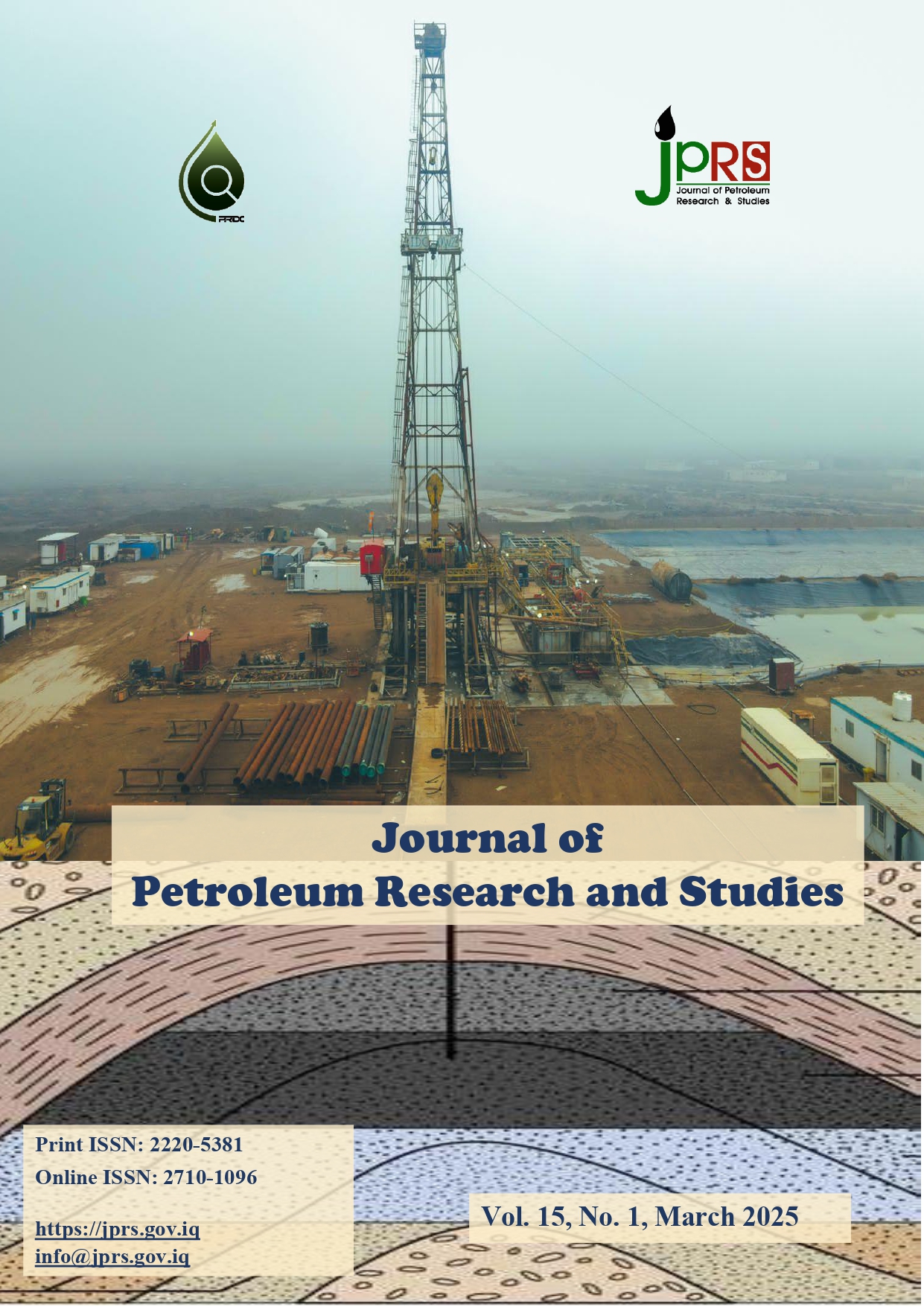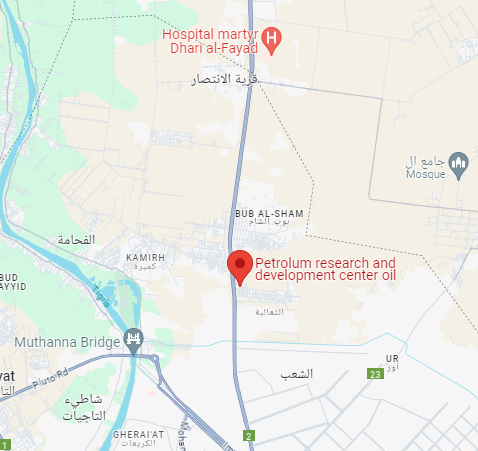تطبيق استخدام التعلم الآلي على إدارة الرمال والخصائص الجيوميكانيكية: دراسة حالة في تكوين نهر عمر، جنوب العراق
DOI:
https://doi.org/10.52716/jprs.v15i1.927الكلمات المفتاحية:
Sand production, CDDP, Sand Management Model, Machine Learning, Wellbore Stability.الملخص
يشكل إنتاج الرمال تحديات كبيرة في صناعة النفط والغاز الطبيعي، مما يتطلب تحليلًا جيوميكانيكيًا شاملاً لتقليل تأثيره في الحقول القائمة. يمثل غياب سجلات الآبار الحاسمة تحديًا أساسيًا في صناعة النفط والغاز، مما يستلزم من الجيولوجيين والمهندسين الاعتماد على المعادلات التجريبية للتنبؤ بغياب تسجيلات الابر.
لقد أجرينا تحليلاً شاملاً للنمذجة الجيوميكانيكية باستخدام جميع السجلات التي تم الحصول عليها من بئرين يقعان في تكوين نهر عمر في جنوب العراق. كان هدفنا تحديد الخصائص الجيوميكانيكية والتنبؤ بحدوث إنتاج الرمال. بالإضافة إلى ذلك، قمنا بالتحقق من صحة المعلمات الجيوميكانيكية المستخدمة في نموذجنا التنبؤي من خلال قياسات. caliper استخدمنا تقنية التعلم الآلي للتنبؤ بغياب السجل الصوتي في Well-5 كبديل للمعادلات التجريبية. علاوة على ذلك، قمنا بإنشاء ومقارنة نموذجين لإدارة الرمال - أحدهما يستخدم معادلة Gardner التجريبية والآخر يطبق تقنيات التعلم الآلي (ML) . نموذج إدارة الرمال المبني على معادلة Gardner تنبأ بإنتاج الرمال منذ البداية. ومع ذلك، فإنها لم تتطابق مع بيانات الإنتاج الفعلية التي تمت ملاحظتها في الحياة الواقعية. ومن ناحية أخرى، أشار النموذج القائم على التعلم الآلي إلى عدم وجود احتمال لتوليد الرمال، وهو ما يتماشى مع بيانات الإنتاج المرصودة.
توضح نتائج هذه الدراسة مزايا استخدام التعلم الآلي على المعادلات التجريبية التقليدية للدراسات الجيوميكانيكية في المنطقة المحددة قيد الدراسة. وتشير هذه النتائج أيضًا إلى إمكانية تطبيق تقنيات التعلم الآلي على المزيد من الأحواض في جنوب العراق. يعمل البحث الحالي على تحسين فهمنا لتأثير التعلم الآلي على إدارة الرمال وكذلك التوصيف الجيوميكانيكي. تتمتع هذه الدراسة بالقدرة على تعزيز إجراءات اتخاذ القرارات في صناعات النفط والغاز الطبيعي والمساهمة بمعارف قيمة في تحسين طرق التعامل مع مشاكل إنتاج الرمال.
المراجع
M. D. Zoback, Reservoirs geomechanics, Department of Geophysics, Stanford University, 2007.
A. K. Abbas, A. Manhalawi, U. Alameedy, and R. E. Flori, "Using an Analytical Model to Predict Collapse Volume During Drilling: A Case Study from Southern Iraq," in 53rd U.S. Rock Mechanics/Geomechanics Symposium, 2019, vol. All Days, ARMA-2019-1525.
A. M. Ayal, D. J. Sadeq, and F. S. Alakbari, "Mechanical earth model coupled with critical drawdown pressure to mitigate sand production in the Nahr Umr Formation, Southern Iraq," Iraqi Journal of Chemical and Petroleum Engineering, vol. 25, no. 4, pp. 93-106, 2024, doi: https://doi.org/10.31699/IJCPE.2024.4.9
A. E. Radwan, "Modeling pore pressure and fracture pressure using integrated well logging, drilling based interpretations and reservoir data in the Giant El Morgan oil Field, Gulf of Suez, Egypt," Journal of African Earth Sciences, vol. 178, p. 104165, 2021. DOI: https://doi.org/10.1016/j.jafrearsci.2021.104165
A. E. Radwan and S. Sen, "Characterization of in-situ stresses and its implications for production and reservoir stability in the depleted El Morgan hydrocarbon field, Gulf of Suez Rift Basin, Egypt," Journal of Structural Geology, vol. 148, p. 104355, 2021. DOI: https://doi.org/10.1016/j.jsg.2021.104355
V. Alipour Tabrizy and Y. Mirzaahmadian, "Investigation of Sand Production Onset: A New Approach Based on Petrophysical Logs," in SPE International Conference and Exhibition on Formation Damage Control, 2012: SPE, pp. SPE-150529-MS. https://doi.org/10.2118/150529-MS.
A. M. Ayal and D. J. Sadeq, "Prediction of Sand Production from Poorly Consolidated Formations Using Artificial Neural Network: A Case Study, Nahr Umr Formation in Subba Oil Field," The Iraqi Geological Journal, vol. 57, no. 2C, pp. 123-138, 2024, doi: https://doi.org/10.46717/igj.57.2C.10ms-2024-9-18
S. K. Subbiah, A. Samsuri, A. Mohamad-Hussein, M. Z. Jaafar, Y. R. Chen, and R. R. Kumar, "Root cause of sand production and methodologies for prediction," Petroleum, vol. 7, no. 3, pp. 263-271, 2021. DOI: https://doi.org/10.1016/j.petlm.2020.09.007.
E. Khamehchi and E. Reisi, "Sand production prediction using ratio of shear modulus to bulk compressibility (case study)," Egyptian Journal of Petroleum, vol. 24, no. 2, pp. 113-118, 2015. DOI: https://doi.org/10.1016/j.ejpe.2015.05.002.
M. Sanei, A. Ramezanzadeh, and M. R. Delavar, "Applied machine learning-based models for predicting the geomechanical parameters using logging data," Journal of Petroleum Exploration and Production Technology, vol. 13, no. 12, pp. 2363-2385, 2023. DOI: 10.56952/ARMA-2022-0522.
W. S. Iramina et al., "Comparing blast-induced ground vibration models using ANN and empirical geomechanical relationships," REM-International Engineering Journal, vol. 71, pp. 89-95, 2018. DOI: 10.1590/0370-44672017710097.
M. A. Al-Janabi, O. F. Al-Fatlawi, D. J. Sadiq, H. A. Mahmood, and M. A. Al-Juboori, "Numerical simulation of gas lift optimization using artificial intelligence for a middle eastern oil field," in Abu Dhabi International Petroleum Exhibition and Conference, Abu Dhabi, UAE, 2021: SPE, p. D022S183R002, doi: https://doi.org/10.2118/207341-MS
H. A. Mahmood, O. F. Al-Fatlawi, M. A. Al-Janabi, D. J. Sadeq, Y. M. Al-Jumaah, and M. Khan, "Optimizing Well Placement with Genetic Algorithms: A Case Study," Journal of Petroleum Research and Studies, vol. 14, no. 4, pp. 37-51, 2024. doi: https://doi.org/10.52716/jprs.v14i4.895
H. A. Al-Musawi, H. N. Al-Saedi, A. Alaa, and O. F. Hasan, "Formulating new oil properties correlations using machine learning," in AIP Conference Proceedings, 2023, vol. 2809, no. 1: AIP Publishing, doi: https://doi.org/10.1063/5.0155900.
M. AlJuboori, M. Hossain, O. Al-Fatlawi, A. Kabir, and A. Radhi, "Numerical simulation of gas lift optimization using genetic algorithm for a Middle East oil field: feasibility study," in International Petroleum Technology Conference, Dhahran, Kingdom of Saudi Arabia, 2020: IPTC, p. D031S095R001, doi: https://doi.org/10.2523/IPTC-20254-MS
Z. A. Al-Sadi and D. J. Sadeq, "Genetic Algorithm-Based Well Placement Optimization: A Review of Studies," The Iraqi Geological Journal, vol. 56, no. 2F, pp. 246-264, 2023, doi: https://doi.org/10.46717/igj.56.2F.16ms-2023-12-22
E. Khamehchi, I. R. Kivi, and M. Akbari, "A novel approach to sand production prediction using artificial intelligence," Journal of Petroleum Science and Engineering, vol. 123, pp. 147-154, 2014. https://doi.org/10.1016/j.petrol.2014.07.033.
U. Alameedy, A. A. Alhaleem, A. Isah, A. Al-Yaseri, A. El-Husseiny, and M. Mahmoud, "Predicting dynamic shear wave slowness from well logs using machine learning methods in the Mishrif Reservoir, Iraq," Journal of Applied Geophysics, vol. 205, p. 104760, 2022. https://doi.org/10.1016/j.jappgeo.2022.104760.
A. R. Ngwashi, D. O. Ogbe, and D. O. Udebhulu, "Evaluation of machine-learning tools for predicting sand production," in SPE Nigeria Annual International Conference and Exhibition, 2021: SPE, p. D031S016R001. https://doi.org/10.2118/207193-MS.
N. Mohamadian et al., "A geomechanical approach to casing collapse prediction in oil and gas wells aided by machine learning," Journal of Petroleum Science and Engineering, vol. 196, p. 107811, 2021. DOI: 10.1016/j.petrol.2020.107811.
A. E. Radwan, D. A. Wood, and A. A. Radwan, "Machine learning and data-driven prediction of pore pressure from geophysical logs: A case study for the Mangahewa gas field, New Zealand," Journal of Rock Mechanics and Geotechnical Engineering, vol. 14, no. 6, pp. 1799-1809, 2022. https://doi.org/10.1016/j.jrmge.2022.01.012.
O. Salman, O. F. Hasan, and S. Al-Jawad, "Permeability Prediction in One of Iraqi Carbonate Reservoir Using Statistical, Hydraulic Flow Units, and ANN Methods," Iraqi Journal of Chemical and Petroleum Engineering, vol. 23, no. 4, pp. 17-24, 2022, doi: https://doi.org/10.31699/IJCPE.2022.4.3
O. F. Al-Fatlawi, "Numerical simulation for the reserve estimation and production optimization from tight gas reservoirs," Curtin University, 2018.
A. M. Abdulaziz, H. L. Abdulridha, A. S. A. Dahab, S. Alhussainy, and A. K. Abbas, "3D mechanical earth model for optimized wellbore stability, a case study from South of Iraq," Journal of Petroleum Exploration and Production Technology, vol. 11, no. 9, pp. 3409-3420, 2021. DOI: https://doi.org/10.1007/s13202-021-01255-6
M. Samnejad, F. Aminzadeh, and A. Bubshait, "Acoustoelastic Estimation of the In Situ Stresses from Sonic Logs for a Carbonate Reservoir," in SPE Western Regional Meeting, 2017, vol. Day 3 Tue, April 25, 2017, D031S007R001. https://doi.org/10.2118/185644-MS.
B. Wu et al., "Sand Production Prediction for A Mature Oil Field Offshore East Malaysia-A Case Study," in SPE Asia Pacific Oil and Gas Conference and Exhibition, 2010. DOI: https://doi.org/10.2118/133375-MS.
A. Qatari, "A Workflow to Estimate Critical Drawdown Pressure Utilizing 1-D Geomechanics Modelling," in Middle East Oil, Gas and Geosciences Show, 2023. DOI: https://doi.org/10.2118/213325-MS.
J.-F. Nauroy, Geomechanics applied to the petroleum industry. Editions Technip, 2011.
J. J. Zhang, Applied petroleum geomechanics, Gulf Professional Publishing Houston, TX, USA, 2019.
B. A. Eaton, "The equation for geopressure prediction from well logs," in SPE Annual Technical Conference and Exhibition?, 1975: SPE, pp. SPE-5544-MS, doi: https://doi.org/10.2118/5544-MS.
G. L. Bowers, "Pore pressure estimation from velocity data: Accounting for overpressure mechanisms besides undercompaction," SPE Drilling & Completion, vol. 10, no. 02, pp. 89-95, 1995, doi: https://doi.org/10.2118/27488-PA.
C. Chang, M. D. Zoback, and A. Khaksar, "Empirical relations between rock strength and physical properties in sedimentary rocks," Journal of Petroleum Science and Engineering, vol. 51, no. 3-4, pp. 223-237, 2006. DOI: https://doi.org/10.1016/j.petrol.2006.01.003.
H. M. Ghargan, O. Al-Fatlawi, and Y. Bashir, "Reservoir permeability prediction based artificial intelligence techniques," Iraqi Journal of Chemical and Petroleum Engineering, vol. 25, no. 4, pp. 49-60, 2024, doi: https://doi.org/10.31699/IJCPE.2024.4.5.
التنزيلات
منشور
كيفية الاقتباس
إصدار
القسم
الرخصة
الحقوق الفكرية (c) 2025 Ali M. Ayal, Dhifaf J. Sadeq, Dennis Delali Kwesi Wayo

هذا العمل مرخص بموجب Creative Commons Attribution 4.0 International License.














